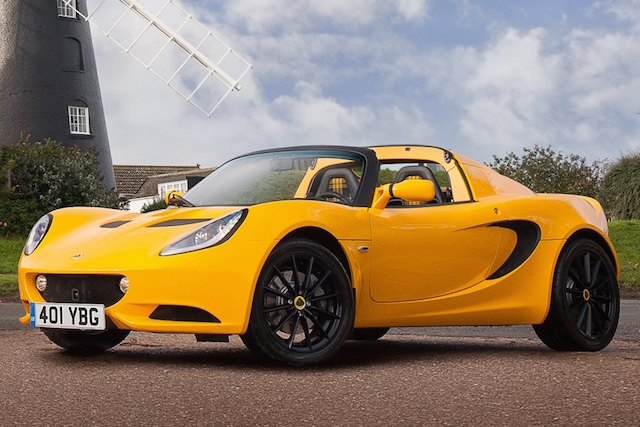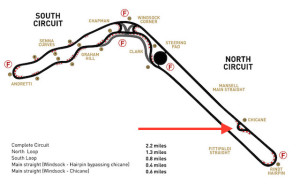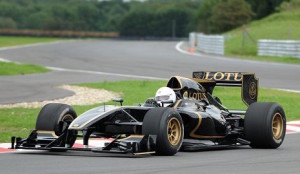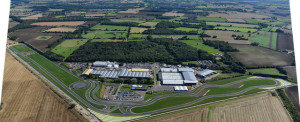
The difference between a V8-powered Formula One Lotus 125 and the four-cylinder Lotus Elise is obviously vast … just how is best experienced on the carmaker’s 3.5km test track at its headquarters at Hethel, in the north-east of Britain.
 There is a chicane on what Lotus has named the ‘Mansell Main Straight’. It’s marked by a red arrow on the layout of the track pictured here. Britain’s Mansell of course is the 1992 Formula One world champion Nigel, a Lotus ambassador.
There is a chicane on what Lotus has named the ‘Mansell Main Straight’. It’s marked by a red arrow on the layout of the track pictured here. Britain’s Mansell of course is the 1992 Formula One world champion Nigel, a Lotus ambassador.
He and former Formula One driver Frenchman Jean Alesi got together to open the new-look test track in June 2011, along with younger drivers Brazilian Bruno Senna and Russian Vitaly Petrov.
I went to Hethel six weeks after the track opened, to drive an Elise S, interview then Lotus CEO Danny Bahar and Classic Team Lotus CEO Clive Chapman, son of Lotus founder Colin.
I already knew what Alesi had said of the circuit, once an airfield used by the US Air Force during World War II: “It’s extremely fast. The first time I went out I was surprised about the length of the straights, but then of course it’s not only for motorsport but for testing road cars. The layout is perfect for that. It’s a proper test track.”

The Lotus 125 is a special project for Formula One wannabees, those with a love of motorsport and plenty of money who want to experience all the thrills of a Formula One drive but in a car that it is easier to control.
Think you’re good enough? Mansell, Alesi and Lotus driving academy director Robert Lechner will put you to the test. If they reckon you can handle the 125, it’s all yours – for around $NZ1.3 million. Lotus will set it up for you and you alone and thereafter you can race it at sanctioned private meetings.
If they conclude you’re not as good as you think you are, that you are throwing big money at something that might kill you … well, you gather your bruisied ego and lie to your friends about how you changed your mind – the 125 wasn’t enough of challenge anyway.

The 125 is powered by a 3.8-litre Cosworth V8 delivering 480kW at 10,000rpm and 450Nm at 7600rpm through a six-speed sequential gearbox. It is a carbon composite with an aluminium core and weighs 590kg unladen. Power to weight ratio is 750kW per tonne. Lotus says it’s as quick as a Formula One car of the late 1990s.
The supercharged Lotus Elise S I drove on the test track weighed around 900kg and used a 1.8-litre Toyota-sourced engine, good for around 160kW and 250Nm. The way the car handles is almost hypnotic. But let’s cut to the chase …
There is a stack of painted tyres that denotes a braking point before the chicane. The chicane itself is not always in use. That’s when you can get through to around 230km/h in the Elise S on the Mansell straight before braking for the (Jochen) Rindt Hairpin. But this day it was in use.
The Lotus driver trainers said I should be doing around 190km/h in fifth gear at this point, before braking hard to scrub off speed and shifting down through fourth and third gear into second to get through the chicane at around 40-50km/h.

Later, after I had spent time alone in the Elise S trying out different entry and exit points, all while trying to get around the circuit as smoothly and quickly as possible, I joined one of the trainers for a chat. The line through Chapman and Windsock Corner was crucial, I said, to gain vital tenths of seconds before having to brake for the chicane.
‘Exactly’, he said. ‘Know what Nigel Mansell is doing in the 125 car at that point? You’re braking at 190km/h in the Elise – he’s braking at 300km/h.’ Right then the world of Formula One became very clear indeed.
The 125 project continues but the Elise and Elise S have been replaced by the Elise Sport (top) and Elise Sport 220, the ‘Sport’ badge returning for the first time on a Lotus since the Esprit.

Both new cars are 10kg lighter than the outgoing models, have 16-inch alloys up front and 17-inch at the rear and will go on sale in New Zealand around the middle of next year. No word on price as yet.
Lotus’ use of Toyota engines and six-speed manual gearboxes continues. The Sport uses a naturally aspirated 1.6-litre unit delivering 100kW at 6800rpm and 160Nm at 4400rpm that gets the 866kg car from 0-100km/h in 6.5 seconds and on to a top speed of 204km/h. Lotus claims town-and-around fuel use of 6.3 litres/100km and C02 exhaust emissions of 149gr/km.
The Sport 220 weighs 914kg and uses a supercharged 1.8-litre four-cylinder engine that delivers 162kW at 6800rpm and 250Nm at 4600rpm. The 0-100km/h sprint time is 4.6 seconds and top speed 234km/h. Fuel use is said to be 7.5 litres/100km with exhaust emissions of 173gr/km.
Both Sport and Sport 220 come with an electronic differential lock and Sport mode switch, which boosts throttle response, takes the reins off the traction control and cancels the stability control’s ‘understeer recognition’ function, all for added fun.
Air-conditioning, cruise control and a hard-top are among the optional extras.
